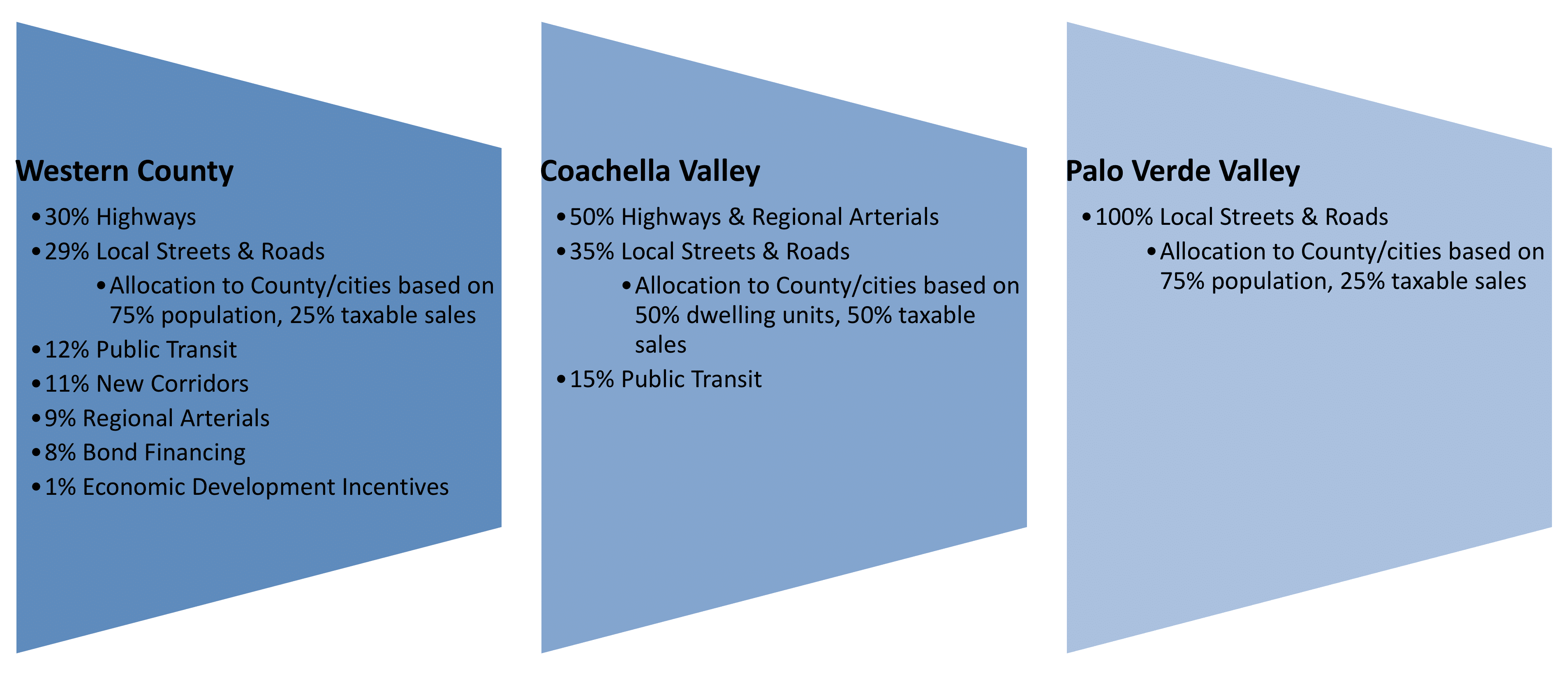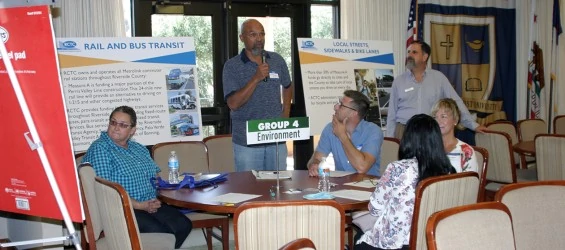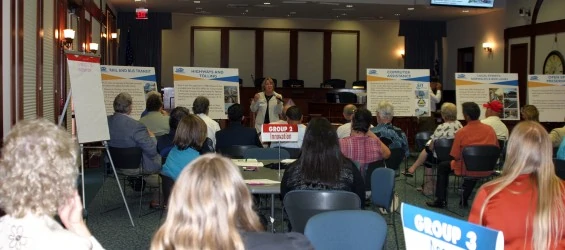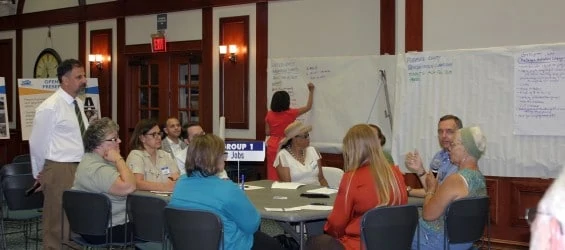RCTC plans and implements transportation and transit improvements, assists local governments with funding for local streets and roads, and helps smooth the way for commuters and goods movements to ensure that everyone in Riverside County has access to transportation.
FUNDING AND PROGRAMMING
RCTC’s annual budget delivers more than $400 million in programs and projects across Riverside County annually. Transportation funding is comprised of local, state, and federal sources, as described in the sections below.
Local Funding
In 1988, when voters approved Measure A, Riverside County’s first half-cent sales tax for transportation improvements, they set in motion a proactive response to growing congestion by spelling out a list of transportation projects to address the problem. RCTC has ensured that the $1 billion raised by Measure A from 1989 to 2009 made a significant difference on virtually every major roadway in the County. Commuter rail, public transit, and commuters also received benefits. In 2002, Measure A was extended by Riverside County voters. Now, Measure A will continue to fund transportation improvements through 2039. Click here to see the expenditure plan and ordinance.
Funds go back to each of three geographic areas within Riverside County: Western Riverside County, Coachella Valley, and Palo Verde Valley, in proportion to the sales taxes they contribute. Each of the three geographic areas has its own transportation program:

In addition to major highway projects, over $1 billion from Measure A has improved local streets and roads everywhere in Riverside County. Between 1990 and 2020 cities and unincorporated county areas received the following Measure A revenues for local streets and roads:
|
Geographic Area |
Measure A (in millions) |
|
Western County |
$ 876.2 |
|
Coachella Valley |
$ 292.8 |
|
Palo Verde Valley |
$ 28 |
|
Total Local Streets and Roads Revenues |
$ 1,197 |
The Riverside County Transportation Commission (RCTC) began developing tolled express lane facilities to improve mobility in 2006. Express lanes provide drivers a choice to pay for reliable travel times and offer a travel option for carpools of three or more as well as transit providers a lane for commuter buses. In addition to the drivers’ travel benefits and commuter buses, the development of these express lane facilities provides RCTC with a significant, long term funding source (tolls) to pay for the development, construction, maintenance, and operations of these toll projects and other transportation improvements along the corridor. The decision to become a tolling agency has and will continue to change RCTC by expanding our mobility mission for decades to come.
The first toll project completed was the 91 Corridor Improvement Project in March 2017. Led by RCTC, the project added regular lanes, tolled express lanes, auxiliary lanes, and direct express lane connectors. Improvements to interchanges, ramps, and surface streets were also made along the 91 corridor. These improvements reduce delays, allow faster emergency response, relieve local street congestion, and offer better access to public transit and trails. Additional information about the 91 Express Lanes is available at: www.91expresslanes.com.
The 15 Express Lanes Project was completed in April 2021. The project improved Interstate 15 in the northwest part of Riverside County. RCTC and its project partners, the California Department of Transportation and the Federal Highway Administration, invested $472 million to improve this stretch of Interstate 15. The project added two express lanes to I-15 in both directions, from Cajalco Road to State Route 60, widened bridges, and added soundwalls. The design-build project was built within the existing median and offers multiple entry and exit points to the express lanes. RCTC is planning for the 15 Express Lanes Southern Extension to Lake Elsinore. For more information, visit rctc.org/15expsouth
RCTC’s third toll project, the 15/91 Express Lanes Connector, was completed in November 2023. The connector provides access to the Express Lanes system from the eastbound 91 Express Lanes to the northbound 15 Express Lanes and from the southbound 15 Express Lanes to the westbound 91 Express Lanes. The 15/91 Express Lanes Connector provides a seamless transition between Riverside County tolling systems for reliable, convenient travel for Eastvale, Jurupa Valley, Norco and Corona residents and express buses.
RCTC now operates and maintain a network of more than 70 lane-miles of tolled express lanes, manages approximately 150,000 customer accounts, and provides Freeway Service Patrol motorist assistance in the express lanes.
RCTC receives regional arterial funds from the Western Riverside Council of Governments’ (WRCOG) Transportation Uniform Mitigation Fee (TUMF) Program. TUMF regional arterial funds are used for roadway improvement projects and the Community Environmental Transportation Acceptability Process projects. To date, approximately $135 million has been programmed for TUMF regional arterial projects.
In 1986, RCTC established itself as the Riverside County Service Authority for Freeway Emergencies (RC SAFE) after the enactment of SB 1199 in 1985. The purpose of the formation of SAFEs in California was to provide call box services and, with excess funds, provide additional motorist aid services. Funding for RC SAFE is derived from a one dollar per vehicle registration fee on vehicles registered in Riverside County. Initially, these funds were used only for the call box program. As additional motorist aid services were developed, SAFE funds were also used to provide Freeway Service Patrol (FSP) and the Inland Empire 511 traveler information services as part of a comprehensive motorist aid system in Riverside County.
In 1990, Proposition C was passed to fund transportation improvements and to help reduce traffic congestion in California. From this, the (FSP) program was created by Caltrans, which developed the corresponding local funding allocation plan to distribute funds to participating jurisdictions through a formula based on population, urban freeway lane miles, and levels of congestion. RCTC, acting in its capacity as the RC SAFE, is the principal agency in Riverside County, in partnership with Caltrans and the California Highway Patrol (CHP), managing the FSP program. The purpose of the FSP program is to provide a continuously roving tow services patrol along designated freeway segments (referred to as beats) to relieve freeway congestion and facilitate the rapid removal of disabled vehicles and those involved in minor accidents on local freeways.
In April 2017, the California Legislature passed, and Governor signed SB 1 which included additional funding for FSP. In March 2018, Caltrans released the SB 1 FSP funding guidelines which allocated $25 million for FSP statewide to participating jurisdictions based on the existing formula. In total, more than $3 million is received annually from the State specifically to support FSP in Riverside County.
Click here for more information on Motorist Assistance services.
State Funding
Senate Bill 1 (SB 1), commonly referred to as the Gas Tax, is the Road Repair and Accountability Act of 2017, which was approved by California’s Legislature and Governor in April 2017 and reaffirmed by voters in November 2018. The Gas Tax generates funds for our transportation infrastructure through increased gasoline taxes and annual vehicle fees. It began providing funds to cities and counties in November 2017. In June 2018, California voters approved Proposition 69, which amended the State Constitution to prevent SB 1 funds from being diverted or borrowed for other purposes.
SB 1 revenues are distributed to the following formula and competitive funding programs:
- State of Good Repair (SGR) Program provides $4 million annually for transit operators in Riverside County
- State Highway Operations and Protection Program (SHOPP) receives $226 million annually statewide
- Transit and Intercity Rail Capital Program (TIRCP) receives $250 million annually statewide
- Commuter and Intercity Rail Program receives $25 million annually for rail operators statewide
- Freeway Service Patrol provides about $1.2 million annually for Riverside County
- Active Transportation Program receives $100 million annually statewide
- State Transportation Improvement Program receives $4.7 million annually for Riverside County
- Trade Corridor Enhancement Program receives $300 million annually statewide
- Solutions for Congested Corridors Program receives $250 million annually statewide
- Local Partnership Program (LPP) receives $200 million annually statewide (60% competitive, 40% formula to self-help counties)
- Local Planning Grants receives $250 million statewide
- Local Streets and Roads Programs receives $84.1 million for cities and unincorporated county areas
RCTC directly receives and/or has oversight responsibilities for SGR, LPP Formula, and Freeway Service Patrol formula funds, and has been awarded over $72 million in other SB 1 competitive programs.
The Transportation Development Act (TDA) of 1971 provides funding to be allocated to transit and non-transit related purposes that comply with regional transportation plans. The TDA provides two funding sources:
- The Local Transportation Fund (LTF) is derived from a quarter-cent of the statewide general sales tax and is returned to the source from which it was generated. The three areas of apportionment within Riverside County are the Western County, Coachella Valley, and Palo Verde Valley. LTF revenues received from the California Department of Tax and Fee Administration are allocated by RCTC for program administration, regional and local transportation planning, bicycle and pedestrian facilities projects, and transit services. LTF provides a dependable revenue stream for Riverside County public transportation operations.
- The State Transit Assistance fund (STA) is derived from the statewide sales tax on diesel fuel. STA is allocated by the state to Riverside County based on population and as a percentage of transit fare revenue. STA revenues received from the State Controller are allocated by RCTC for capital projects related to Riverside County’s public transit operators.
State law requires RCTC to award and oversee the use of TDA funds to transit operators and local jurisdictions in the county. Per Article 3 of the TDA, LTF funds may be utilized for planning studies, bicycle and pedestrian facilities, grade separations, and transit operations and capital. STA funds are used for transit capital and operations. RCTC allocates LTF and STA funds for transit purposes annually through the approval of each transit operators’ Short Range Transit Plan (SRTP), and accounts for about 57% of total annual transit expenditures. LTF funds used for bicycle and pedestrian facilities is held through a biennial call for projects.
Click here for more information on the SRTP.
Click here for more information on the Bicycle and Pedestrian Facilities Call for Projects.
Please register for Rivtrack to submit a grant application.
The Active Transportation Program (ATP) is administered by the California Transportation Commission (CTC) and was created to encourage increased use of active modes of transportation, such as biking and walking. The ATP consolidates various transportation programs, including the federal Transportation Alternatives Program, state Bicycle Transportation Account, and federal and state Safe Routes to Schools programs into a single program to:
- Increase the proportion of biking and walking trips,
- Increase safety for non-motorized users,
- Increase mobility for non-motorized users,
- Advance the efforts of regional agencies to achieve greenhouse gas reduction goals,
- Enhance public health, including the reduction of childhood obesity through the use of projects eligible for Safe Routes to Schools Program funding,
- Ensure disadvantaged communities fully share in program benefits (25% of program), and
- Provide a broad spectrum of projects to benefit many types of active transportation users.
Since 2018, funding for each program cycle (four funding years per cycle) has totaled approximately $440 million. Funding is distributed in three components: statewide (50%), large Metropolitan Planning Organization (MPO) (40%), and rural (10%). Applicants have the opportunity to be awarded at either the statewide level or the MPO level. At the MPO level, county transportation commissions, such as RCTC, are responsible for working with the Southern California Association of Governments to recommend projects for award.
For more information about the Active Transportation Program, please visit the CTC website.
The Low Carbon Transit Operations Program (LCTOP) is funded from the Greenhouse Gas Reduction Fund. This program is aimed at providing operating and capital assistance for transit agencies to reduce greenhouse gas emissions and improve mobility with a priority to serve disadvantaged communities. Caltrans, as the administering agency for LCTOP, prepares allocation shares to regional entities determined by formula, based on population and ratio of revenue of transit operator’s jurisdiction to the total operator revenues in the state. Eligible recipients include transportation planning agencies, county transportation commissions, and transit operators.
As part of SB 125, ridership information is made available to the public that includes information for all transit operators by service mode in Riverside County.
Click here for more information on Motorist Assistance service.
FEDERAL FUNDING
RCTC receives and allocates funding from the Federal Highway Administration through the current federal transportation bill, Fixing America’s Surface Transportation Act (or “FAST Act”) that was signed in December 2015 by President Obama. The FAST Act authorized $305 billion over fiscal years 2016 through 2020 for the Federal Highway Administration (FHWA), Federal Transit Administration (FTA), Federal Motor Carrier Safety Administration, Pipeline and Hazardous Materials Administration, National Highway Traffic Safety Administration, and Federal Railroad Administration. FHWA provides two funding sources for which RCTC is responsible. The Commission may nominate projects or hold a call for projects to award FHWA funds.
Surface Transportation Block Grant (STBG)
The STBG is intended to fund a wide range of transportation projects from capital improvements to planning activities. Projects previously approved for STBG funds include freeway interchanges, roadway widening, signal installations, road rehabilitations, and planning studies.
Congestion Mitigation and Air Quality (CMAQ)
CMAQ funds are targeted at transportation projects that benefit both congestion and air quality. Projects must undergo an air quality analysis demonstrating emissions reductions. In general, projects that add capacity are not eligible under this program. Projects previously approved for CMAQ funds include the purchase of transit vehicles, High Occupancy Vehicle (HOV) lanes, rail stations, new and expanded transit service, and signal synchronization projects. The Commission delegates the selection of projects for CMAQ funds apportioned to the Salton Sea Air Basin to the Coachella Valley Association of Governments.
Please visit the FHWA website for more information on highway funding programs
RCTC receives funding from the Federal Transit Administration through the current federal transportation bill, Fixing America’s Surface Transportation Act (or “FAST Act”) that was signed in December 2015 by President Obama. The FAST Act authorized $305 billion over fiscal years 2016 through 2020 for the Federal Highway Administration (FHWA), Federal Transit Administration (FTA), Federal Motor Carrier Safety Administration, Pipeline and Hazardous Materials Administration, National Highway Traffic Safety Administration, and Federal Railroad Administration.
FTA provides funding to local public transit systems in Riverside County for commuter rail, bus, and vanpool services. FTA funds include annual formula grants to transit agencies nationwide as well as discretionary funding in competitive processes. Formula funds in large-urbanized areas are designated to metropolitan transportation organizations, which in this region is the Southern California Association of Governments (SCAG). SCAG is responsible for establishing a public participation process for approving the federal program of projects and relies on county transportation commissions such as RCTC to review and approve the program of projects within their respective counties. Formula funds in small urban and rural areas are designated to the state and are administered by Caltrans. Core FTA programs include Section 5307 Urbanized Area Formula, Section 5310 Enhanced Mobility for Seniors and Individuals with Disabilities, Section 5337 State of Good Repair, and Section 5339 Bus and Bus Facilities. FTA revenues comprise about 16% annually for transit expenditures in Riverside County.
Please visit the FTA website for more information on transit funding programs.
Plans & Studies
RCTC, with grant funding from the Federal Transit Administration, completed the Transit-Oriented Communities (TOC) Strategic Plan in April 2024, in collaboration with the cities of Corona, Riverside, Moreno Valley, Perris and the March Joint Powers Authority. The Strategic Plan serves as a planning and development resource for the communities along the 91/Perris Valley Line. It consists of the Corridor-Wide Plan and eight Station Vision Plans to provide coordinated guidance at both the corridor and individual station level. The Corridor-Wide Plan summarizes the project process, public input, and overall corridor vision, as well as the corridor-wide implementation strategies that apply to all the station areas. The eight Vision Plans detail station-specific recommendations and priorities relating to land use, mobility and placemaking. Note, all projects identified in the plans are preliminary. The responsible agency will need to determine whether to advance the projects, feasibility, prioritization, funding, environmental clearance, and design.
Click here to view the Corridor-Wide Plan
Click here to view the Corridor-Wide Plan Appendix
Click here to view the Vision Plans
In partnership with San Bernardino County Transportation Authority (SBCTA), Caltrans District 8, and Southern California Association of Governments (SCAG), RCTC has developed the Inland Empire Comprehensive Multimodal Corridor Plan (IE CMCP). The IE CMCP goes beyond traditional freeway planning efforts and identify potential multimodal infrastructure opportunities within Western Riverside County and the valley-area of San Bernardino County. Completing the IE CMCP is required for regional transportation planning agencies such as RCTC to compete for funds through the State’s SB 1 Solution for Congested Corridors Program.
The Short Range Transit Plan (SRTP) is a five-year operating and capital plan that focuses on the regional transit programs RCTC directly administers. These programs include commuter rail service operated by the Southern California Regional Rail Authority as known as Metrolink in Western Riverside County, the Coachella Valley Rail Program Development, and the relatively new vanpool program, VanClub. The SRTP is updated annually and serves as a blueprint on how service will be implemented and identifies the capital priorities for the next five years.
Click here to view the FY 2024/25 – 2028/29 RCTC SRTP.
Additionally, RCTC is responsible by State statute for coordinating and approving all public transit operators’ Short-Range Transit Plans in Riverside County. The SRTP is intended to serve three purposes:
- Identify the transit services and capital improvements required to meet the transit needs of Riverside County over a three to five-year period and the proposed sources of funding to carry out the plan;
- Serve as a management tool for the operators to guide their activities over the next year; and
- Provide justification for operating and capital assistance for grant applications to be submitted to state and federal funding agencies.
The SRTP is also the primary mechanism used by the Commission for approving and programming federal, state, and local funds. Each of the seven bus operators maintains the latest version of their SRTP. Click to visit their websites.
The Traffic Relief Plan is a landmark transportation strategy aimed at reducing traffic bottlenecks and improving roadway and public transportation infrastructure that will help foster a stronger, more sustainable economy for Riverside County communities.
Approved by the Riverside County Transportation Commission (RCTC) on April 10, 2024, the Plan outlines aspirational transportation solutions in Riverside County for Riverside County residents.
The updated Plan identifies the need to invest in crucial transportation projects, services, and infrastructure, including public transportation, roadway safety, highway improvements, active transportation, securing infrastructure from natural disasters, and environmental mitigation. These updates build upon RCTC’s previously approved 2020 TRP and draft 2024 TRP.
Click here to view the 2024 Traffic Relief Plan | 2024 Traffic Relief Plan (Spanish Version)
RCTC, the Orange County Transportation Authority (OCTA), and Caltrans are responsible for coordinating improvements to State Route 91 in Riverside County and Orange County. Senate Bill 1316, adopted in 2008, required the creation of an advisory committee comprised of board members from RCTC and OCTA. SB 1316 also required annual updates of an implementation plan of SR-91 improvements for the Legislature. The State Route 91 Implementation Plan was completed by OCTA and RCTC, in consultation with Caltrans, and outlines proposed projects, transit service charges, and completion schedules for transportation improvements to Metrolink, express bus, freeways and interchanges, express lanes, new east-west highway corridors, and high-speed rail.
Click the link to learn more about the 91 Implementation Plan.
RCTC has been proactive in providing travelers and commuters multiple ways to traverse throughout Riverside County. RCTC embarked on an ambitious goal to provide additional Rail services throughout the county. After implementation of the Perris Valley Line rail project connecting the City of Riverside to the City of Perris, RCTC embarked on a Rail study to continue to expand long-term options for commuters.
RCTC is embarking on an exciting effort to develop the first countywide Long Range Transportation Study (LRTS). The LRTS was kicked off in mid-2017 and will be completed in early 2019. It will provide a vision for what an integrated transportation system will look like in Riverside County in the next 20 years. The plan is taking a comprehensive review of projects on the state highway, regional arterials, rail and bus, freight network, and active transportation. It also will identify potential “bundles” of projects that can be developed in a systematic approach, demonstrate environmental benefits, and put RCTC and its member agencies in a more competitive position to score well under cost/benefit analyses when seeking funding for transportation improvements. This effort will also help RCTC better prioritize and coordinate the different planning efforts across the county with state, regional, and local agencies.
RCTC began a study in spring 2017 to evaluate a logistics-related regional fee on new warehousing facilities. The study is the result of a settlement agreement between RCTC, the County of Riverside, the City of Moreno Valley, and Highland Fairview in response to litigation involving the World Logistics Center. Highland Fairview is the developer of the World Logistics Center, which is planned to encompass more than 40 million square feet of large-scale logistics operations in the eastern portion of Moreno Valley. In May 2019, the Commission approved the Regional Logistics Fee Nexus Study. The study could lead to a new program that would, for example, set a fee on new distribution center warehouses to offset the cost of highway improvements caused by the growth in truck trips originating or ending in the county.
RCTC has been proactive in providing travelers and commuters multiple ways to traverse throughout Riverside County. In 2006, RCTC embarked on an ambitious goal to provide reliable and predictable trips via express lanes in Western Riverside County. Riding on the heels of two successful express lane projects along SR-91 and I-15, RCTC sought to provide the benefit of express lanes to travelers and commuters by expanding its current express lane network. This study identifies the most promising new and/or expanded express lane facilities within Riverside County.
RCTC has been proactive in reducing the effects of goods moving by train and trucks through Riverside County by conducting grade separation priority studies and developing a funding strategy to secure funding for local jurisdictions. RCTC’s most recent Grade Separation Priority Update Study in 2012 evaluated and prioritized the remaining 46 at-grade crossings. In 2017, a Companion Study to the 2012 study was completed to update information regarding improving each of the remaining 46 at-grade crossings.
Click here to learn more about the 2017 Grade Separation Companion Study..
Click here to learn more about the 2012 Grade Separation Priority Update Study.
In 2016, RCTC completed a Strategic Assessment of Riverside County’s transportation needs at that time and for the future. The process included extensive public input and technical analysis. More than 200 community members participated in RCTC’s Transportation Summits around Riverside County. At each Summit, residents shared their vision for our transportation future in a collaborative dialogue. The results of the public’s feedback were integrated with data regarding the county’s future growth and funding expected to be available.
The Strategic Assessment was instrumental in leading to the development of the Next Generation Toll Feasibility Study, Next General Rail Study, and Long Range Transportation Study.
In accordance with the Federal Transit Administration Section 5310 Program, RCTC is responsible for developing a Public Transit – Human Services Coordinated Plan (Coordinated Plan) to incorporate all forms of transit options in the county including: Public transit operators and non-profit and public social service transportation providers. This plan is required to be updated every four years to identify gaps in service and set funding priorities. RCTC is currently in the process of updating the Coordinated Plan, which will be completed by the end of 2020.
RCTC is the agency charged with recommending projects proposed for funding under the Regional Transportation Plan/Sustainable Communities Strategy (RTP/SCS). The RTP/SCS identifies strategies to meet mobility of all modes, legislative, financial and air quality requirements in the six county area of Southern California and is overseen by the Southern California Association of Governments (SCAG). This plan is updated every four years, most recently in 2020.
RCTC’s Road to Recovery plan was prepared after the Great Recession severely impacted Measure A and state and federal revenues for transportation. RCTC was forced to scale back and defer projects, due to lack of funding. RCTC recognizes that the deferred projects need to be built to address traffic congestion, but the agency is constrained by the funding that is available. In an ideal world, funding would be available to complete a full range of transportation projects, but reality forces RCTC’s Commissioners to make tough choices and prioritize transportation funding decisions. This document shows the thought process behind that prioritization process in 2010.
Programming Documents
The California Transportation Commission administers the State Transportation Improvement Program or STIP. The STIP consists of Regional Improvement Program (RIP) and Interregional Improvement Program (IIP) funds for projects that expand transportation capacity. As the regional transportation planning agency, RCTC selects projects proposed for RIP funds. Caltrans selects IIP-funded projects. RCTC and Caltrans District 8 work closely in coordinating projects for these fund sources. The STIP is updated and approved by the CTC biennially every even-numbered year. The STIP serves as a five-year plan for future allocations.
STIP funds can be used on state highway improvements, intercity rail, and regional highway and transit improvements. The Commission approved the 2024 STIP in October 2023 and the CTC is anticipated to adopt it in March 2024.
Click here to see RCTC’s 2024 STIP RIP.
Click here for the CTC 2024 STIP.
The FTIP is a six-year programming document that is updated biennially on odd-numbered years and identifies all of the federally-funded and regionally significant projects that each region plans to implement. As the Regional Transportation Planning Agency (RTPA) for Riverside County, RCTC submits projects into Southern California Associated Government’s (SCAG) FTIP database on behalf of all agencies within Riverside County consistent with the Regional Transportation Plan/Sustainable Communities Strategy (RTP/SCS).
Click the link for the 2021 SCAG FTIP.
The FSTIP is a four-year programming document which includes all FTIP and STIP projects for the State of California, and is prepared by Caltrans in cooperation with the Metropolitan Planning Organizations and Regional Transportation Planning Agencies. The FSTIP is approved by federal agencies as the official list of projects for the State of California. RCTC’s contribution to the FSTIP is the combination of all projects within the FTIP and STIP.
Click the link for the 2021 FSTIP.
Funding Opportunities
Each year, 2% of the Local Transportation Fund (LTF) revenue is made available for bicycle and pedestrian facility projects under TDA Article 3, also known as SB 821. Eligible projects include sidewalks, access ramps, bicycle facilities, and bicycle plan development. RCTC issues a Call for Projects biennially in February of odd-numbered years and funds are allocated to local agencies each June. An evaluation committee reviews and ranks the projects based on evaluation criteria approved by the Commission. The evaluation committee, composed of individuals from the Technical Advisory Committee and other active transportation experts, makes recommendations for projects and funding award amounts to the Commission for their final approval. In June 2019, RCTC awarded approximately $3.9 million to pedestrian and bicycle projects in Riverside County. RCTC released the current call for projects in February 2021.
The 2021 TDA Article 3 Call for Projects is released in February of every odd-numbered year. Please revisit this webpage for updates. For future notifications, you may submit your contact information here to join our e-mail list.
Click here for the FY 21/22 SB 821 Guidelines
Click here to download the Grant Application
Click here to submit application through the SB 821 Portal



